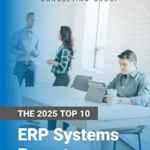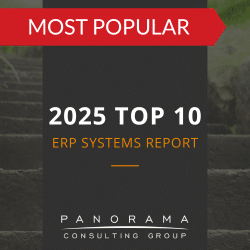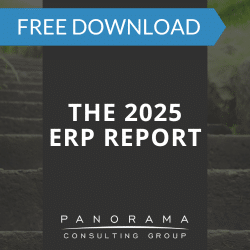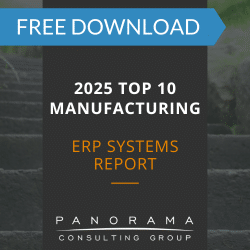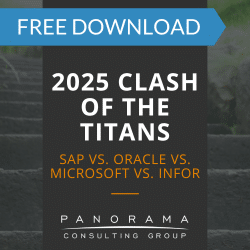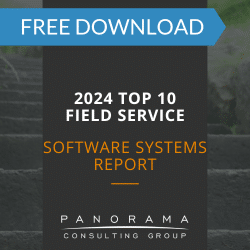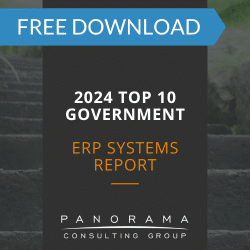- Early signs of market disruption often surface in how internal systems respond to shifting customer expectations and competitive pressure.
- Market disruption indicators within your tech stack can include rising manual workarounds, inflexible data structures, and growing integration demands.
- A future-proof business strategy requires agile platforms and adaptable governance models.
- ERP data can expose gaps in responsiveness that signal a need for faster decision-making and operational flexibility.
It rarely starts with a headline. Most disruptions begin quietly—through a shift in customer expectations, a competitor’s faster delivery model, or a new technology that reshapes executive decision-making.
The companies that stay standing are the ones whose systems, data, and teams were already positioned to pivot.
Today, we’re revealing what it takes to stay ahead of market disruption, why most companies miss the signs, and how to design a future-proof business strategy.
The 2025 Top 10 ERP Systems Report
What vendors are you considering for your ERP implementation? This list is a helpful starting point.
Market Disruption Indicators Hidden in Your Tech Stack
Waiting for traditional benchmarks to signal change is no longer a viable approach—especially when disruptive competitors often operate outside the bounds of typical industry metrics.
For instance, we’ve seen digitally native startups enter mature industries by offering instant quoting, zero-touch onboarding, and real-time delivery tracking—capabilities that rarely show up in standard competitor analyses.
Here are five market disruption signals that may be right within your IT environment:
1. Your systems are producing more workarounds than insights.
When employees regularly bypass business systems using spreadsheets and manual workarounds it’s often because the underlying workflows no longer align with business needs.
This should prompt a competitive analysis. Have your competitors built more agile processes, such as:
- AI-driven customer support that resolves inquiries before escalation?
- Dynamic pricing engines that adjust in real time based on demand signals?
- Self-optimizing supply chain workflows that respond instantly to disruptions?
2. Legacy data models are blocking new service models.
Many ERP environments were built to support product-centric businesses. However, as entire industries shift toward subscription models, consumption-based pricing, and hyper-customization, rigid data structures become a silent threat.
If your ERP system can’t handle evolving revenue streams, product variants, or usage data, then disruption is already knocking. This is when it becomes essential to rethink your data architecture.
- Can it support real-time customer insights, automated decision-making, and rapid iteration? Minor changes, like testing a new pricing tier, shouldn’t take months.
- Does it allow you to launch new products, adjust pricing, and personalize services faster than competitors? Every change shouldn’t require custom development and IT involvement.
3. Integration requests are rising faster than system improvements.
When an increasing number of employees are asking for APIs, third-party app support, and direct system-to-system communication, it might be a sign that your core platform is struggling to keep pace with process requirements.
Here’s how you know it’s time to rethink your IT strategy:
- Competitors are gaining traction by implementing platforms with native integrations.
- You’re seeing delays every time a new tool needs to be added to your tech stack.
- IT is spending more time maintaining connectors than improving core functionality.
4. Forecast accuracy is declining despite better tools.
Many companies invest in advanced analytics without questioning whether the data flowing into these models reflects current market dynamics.
A decline in forecast accuracy—even after an upgrade—often suggests that underlying assumptions are out of date.
We recommend the following best practices:
- Using forecasting models that adapt to real-time demand.
- Auditing data sources regularly to ensure inputs reflect current customer behavior.
5. Strategy workshops feel increasingly detached from operational reality.
When leadership conversations aren’t grounded in systems, processes, and data, disruption risk grows.
The most agile organizations ensure that strategic goals are quickly reflected in how their systems, processes, and teams operate. Following are some ways to accomplish this:
- Integrate strategy changes directly into ERP planning cycles and release roadmaps.
- Ensure cross-functional teams review operational feasibility before launching initiatives.
- Avoid assigning major transformation efforts to isolated task forces disconnected from core operations.
Using Enterprise Software to Future-Proof Your Business Strategy
Business transformation efforts often fail because they’re planned too rigidly, with timelines and methods that don’t match the speed of market changes.
Our ERP selection consultants like to use the following best practices when future-proofing business strategies:
1. Prioritize platform flexibility over feature parity.
Too many ERP selections are driven by a checklist approach—prioritizing what a system can do today rather than how it can evolve tomorrow.
We often advise clients to look for a flexible ERP system that can incorporate new data sources, dynamically adapt workflows, and scale into new business models. Many of the top ERP systems make it easy for non-technical users to configure workflows. This allows the business to respond faster when customer needs or market conditions shift.
2. Create a governance model that welcomes innovation without breaking compliance.
Governance is often seen as the enemy of innovation, but it doesn’t have to be. By structuring governance around cross-functional decision-making you can more quickly adopt emerging technologies.
This is essential when industry disruption forces rapid change.
For example, a manufacturing company might decide to rapidly shift sourcing to new regional suppliers to maintain production during a supply chain disruption. However, without adaptive governance, procurement teams could be delayed by outdated approval workflows and disconnected compliance checks.
3. Redesign your performance metrics to spotlight change-readiness.
Traditional ERP dashboards emphasize efficiency, cost, and throughput—but none of those reveal whether your organization is ready for change.
Instead, look at metrics such as time-to-reconfigure, percent of manual overrides, or lag between forecast deviation and executive visibility. These tell you how agile your enterprise is.
Our ERP implementation consultants have helped a number of professional services clients leverage ERP data to monitor KPIs such as response times to shifting client demands. Then, we can adjust core processes to enable the business to pivot quickly without disrupting service delivery.
4. Invest in scenario-based simulation before you need it.
Many organizations build what-if analyses and simulation tools into their IT strategies from day one. This allows them to test how market shifts—like a supply chain breakdown or pricing war—could affect their business.
However, more commonly, organizations lack the ability to quickly test scenarios, adjust forecasts, and make informed decisions.
We recommend building scenario templates within your ERP system that allow you to quickly compare cost, revenue, and capacity impacts across regions, products, and customer segments. This might entail creating templates that simulate a drop in available labor or a key supplier going offline for 30 days—so decision-makers can immediately see how those changes affect margins, timelines, and resource availability.
Learn More About Identifying Industry Disruptors
The impacts of disruption often appear gradually—in the gaps between what your systems can do and what your market now demands.
To future-proof your business you must select enterprise software that evolves with you, empower teams to test and adapt quickly, and use data to spot hidden market disruption indicators. Contact our independent ERP consultants to learn how.
